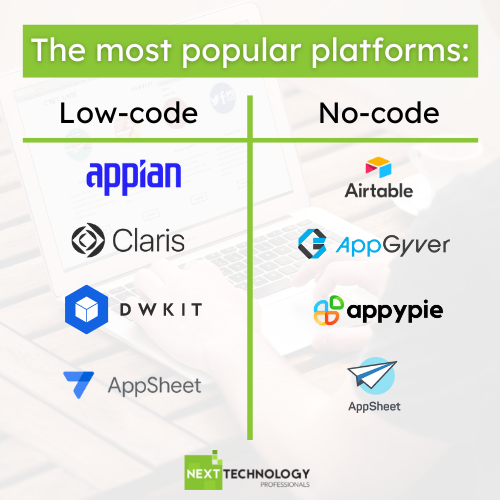Top Info For Choosing application development with Low-code platforms
Top Info For Choosing application development with Low-code platforms
Blog Article
Benefits Of Low-Code Development To Non-Developers With Regard To Accessibility
App development that is low-code improves accessibility for non-developers (often referred to as "citizen-developers") due to certain key aspects.
Drag-and-Drop Builders : Low-code platforms offer drag-and–drop interfaces which enable non-developers, who do not need to write code, to build visually-based applications. This makes it easier for people who don't have technical background to participate in the process of development.
WYSIWYG editor: The "What you see is what you will get" editors allow users to create interfaces, workflows and other functions in a manner that is similar to the final product. They are easy to comprehend and use.
Simple Workflow and Logic Design
Visual Workflow Design: Users can easily design business process and application logic by using diagrams, models, and flowcharts. They are simpler to use than traditional coding.
Logical Components Pre-built: Many low-code platforms come with pre-built components for logic (e.g. conditions, loops) and are easily configurable. This eliminates the need to code complex programs.
Reusable templates and components:
Library of Pre-built Templates: Numerous low-code platforms have templates for common application types, enabling non-developers to start with a solid foundation to alter as required.
Reusable Modules and Widgets: Users can make use of reusable widgets and modules to streamline the process of creating them and eliminating the need for in-depth technical knowledge.
Guided Development and Tutorials
Step-byStep Guides: Platforms will typically provide a development path with guidance, online tutorials, or on-screen directions to help non developers in creating applications.
Interactive Tutorials: Interactive, hands-on tutorials help users learn by doing, increasing their comprehension and confidence making use of the platform.
Integration with Existing Tools:
Integration seamless: Low-code platforms have been designed to easily integrate with existing business systems and tools (e.g. CRM, ERP) making it possible for non-developers to develop applications within their current workflows.
APIs and Connectors APIs built-in and connectors simplify the integration process, enabling non-developers to connect their apps with external services, without requiring complex coding.
Collaboration Features:
Team Collaboration: Features like real-time collaboration, as well as shared workspaces enable non-developers to work with business analysts, professional developers and other stakeholder groups effectively.
Access Control Based on Roles: Non-developers can be assigned roles and access levels that permit users to contribute, without compromising security or functionality.
Automated Testing and Debugging
Test Tools Included: A lot of low-code platforms have built-in debugging and testing tools. These tools streamline the procedure, making it simple for non-developers ensure that their apps are functioning properly.
Error Highlighting: If problems occur the platform highlights any the errors and suggests solutions by guiding non-developers through troubleshooting techniques.
The capability of low-code apps to allow development for those who are not developers is its main advantage. Platforms that use low-code empower business users with an intuitive, visually and logical tools. They can then actively take part in the process of developing and maintaining the applications. View the most popular published here on Low-code Platform for application development for blog info including push alerts, develop mobile application, develop web app, low code platforms, software for app development, application modernisation, app development platform, no code platforms, ms azure sql, build with docker and more.
Benefits Of Low-Code Applications In Safety And Governance
Low-code applications offer several benefits for cybersecurity and governance that are essential to ensure that applications are properly managed, controlled, and compliant throughout their lifespan. Here are a few of the most important advantages:
Unified management console: Low-code platforms usually provide a central administration console where administrators are able to manage all the applications and maintain a consistent governance within the organization.
Role-Based Access Control RBAC : These platforms typically have robust access controls that are based on roles. They allow administrators define and enforce policies. Only authorized users are permitted to modify and access specific areas of an application.
Compliance and Regulatory Adherence
Many low-code platforms include built-in compliance functions. For instance, they are designed in accordance with the industry standards as well as regulations and laws (e.g. HIPAA, GDPR). They provide tools and templates to ensure that their applications comply with these standards.
Audit trails and logs: Comprehensive audit trails and logging can be combined. This lets organizations track and monitor changes and access, as well as ensure conformity with internal rules as well as external regulations.
Enhance Security Measures
Data encryption: Low-code platforms generally provide encryption built-in for data that is in storage and during transit, which ensures that data with sensitive information is secure.
Security Certifications: A lot of low-code companies have security certifications (e.g., ISO 27001, SOC 2) that prove their compliance with high security standards, providing additional assurance to users.
Automated Security Updates
Regular Updates and Patches Low code platforms usually are capable of handling patches and security updates on a regular basis. This means that apps are protected against the most recent threats without the need for developers to manually alter their settings.
Security Monitoring: Constant security monitoring tools can be included to provide real-time notifications and information on security concerns.
Data Governance
Data Access Policies: These software tools enable organizations to define the data access policies, enforce them and keep track of policies. This ensures that data is only accessible to authorized users and are used in a proper manner.
Data Masking, Anonymization and Anonymization Tools: These programs help secure sensitive personal information and are especially useful for testing environments.
Consistent Application Management:
Pipelines for development and deployment: Low-code platforms provide integrated development and deployment, which includes security checks. This provides security throughout the lifespan of the application.
Version Control - Integrated version controls helps keep track of modifications to applications and allow the application to be reversed in the event of need. They also maintain the integrity and integrity of the application.
User Authentication:
Single Sign-On - Support for single sign-on (SSO) and other advanced authentication mechanisms, simplifies management and increases security.
Multi-Factor Authentication Numerous platforms allow multi-factor Authentication that adds an extra layer of security when accessing apps.
Policy Enforcement and Compliance Monitoring:
Low-code platforms are usually pre-defined with policy templates to help organizations implement governance and security policies quickly.
Compliance Monitoring Tools - These tools permit constant monitoring of compliance status and provide the ability to report, making it easier to find and correct possible issues.
Integrating with Existing Security Infrastructure
Integration seamless: Low-code platforms can easily be integrated into the existing security tools and systems like firewalls and SIEM solutions (Security Information and Event Management), and identity management systems.
API Security API Security features ensure integrations with external systems, safeguarding information and ensuring integrity of applications.
Best practices and Training
Guided best practices: Many platforms include guidelines and recommended methods for developing secure applications. These help non-developers meet security standards.
Some low-code providers provide security training to help users develop and maintain secure apps.
The governance and security features of low-code applications make sure that they are managed and built in a compliant and controlled manner. These platforms offer all the tools and frameworks needed to protect sensitive data and enforce policies while maintaining the regulatory compliance. Read the best Legacy application modernization with Low-code for blog tips including low code platforms, rad development, jdbc server, push notifications, cross platform mobile app development, mobile development platforms, develop web app, application modernization, ms azure sql, rad application development and more.
Low-Code Software Can Be Beneficial In The Area Of Collaboration And Workflow
The low-code approach to development of applications offers a variety of advantages in terms of collaboration and workflow, which makes it a great choice for companies seeking to improve team productivity and speed up their process of development. Here are the top benefits: Improved Cross-Functional Collaboration:
Unified Development Environment Low-code platform provides one unified environment in which all employees such as analysts, developers as well as designers, stakeholders, and more, can efficiently work together. This eliminates silos and fosters more effective communication.
Visual Development Tool: The drag and drop nature of platforms that use low-code technology makes it easy for team members who aren't technologically inclined to participate in the process of development. They can assure that business needs are precisely analyzed and implemented.
Communication Enhancement
Real-Time Co-operation: A lot of platforms with low-code support real-time co-operation capabilities like commenting, editing in parallel and immediate feedback. They facilitate continuous communication by cutting down on the amount of time required for back-and-forth discussion.
Shared Workspaces: Teams are able to collaborate in shared workspaces where they can view the, edit and debate aspects of projects, ensuring that everyone is on the same page and working towards common goals.
Streamlined Workflow Management:
Integrated Project Management Tools: A lot of low-code software platforms include integrated tools for project management that help teams monitor and plan their development projects. This includes the management of tasks, tracking progress and deadline management.
Workflow Automation Automating repetitive tasks as well as workflows will reduce errors and efforts, allowing the team to concentrate on strategic activities while improving efficiency.
Faster Iteration:
Rapid prototyping: Low code platforms enable rapid prototyping, iterative development and quick prototyping. This enables teams to create applications to test and improve their designs in less time. This provides rapid feedback and further improvement.
Agile Development Support Supporting agile methodology allows teams and individuals to work in small steps. This also makes it possible to swiftly adjust to changes.
Accessibility for non-Developers
Citizen Development: Low-code platforms empower business users (citizen developers) to develop and modify applications without requiring a lot of coding experience. This reduces the burden of IT and development departments and helps them react quicker to business demands.
Training and onboarding. Tools that are intuitive and comprehensive training materials help the new team member get up-to-speed, improving the overall level of collaboration.
Centralized Documentation and Knowledge Sharing
Integrated Documentation: Low-code platforms offer a wide range of tools that allow for the creation and maintaining of documentation on the platform. This will ensure that all project data is accessible and centrally stored.
Knowledge Repositories: Teams can create and maintain knowledge repositories that include best practices, templates, and reusable components, which aid in knowledge sharing and reducing repetition of efforts.
Consistency in Standardization
Standardized components: A standardized components, built in advance, ensures consistency in the applications. Team members can comprehend and work with greater ease with different components.
Governance and compliance Governance and compliance: Integrated governance frameworks ensure that development conforms to organizational standards and regulatory requirements. This decreases the chance of non-compliance, as well as helping applications comply with quality standards.
Feedback and Improvement Loops
Integrated Feedback Systems: Low-code platforms offer integrated feedback systems that permit users to provide feedback to the applications. The feedback could later be used in the development of the applications.
Continuous Improvement: The ability to quickly test and implement modifications in response to feedback allows for constant improvement of software. They are closely aligned with the needs of users and business goals.
Visualization and reporting
Real-Time Analysis Tools for Analytics and Reporting included in the software offer instantaneous information about project progress, user interaction and performance. This allows for the use of data to make decisions.
Visual Workflow Maps: Tools for mapping workflows or processes are helpful to teams in understanding their workflows. They can also be used to pinpoint the bottlenecks that are present, as well as areas that require improvement.
The main benefits of developing low-code applications in terms of collaboration and workflow are in its capacity to unite teams from different backgrounds, streamline communication, and streamline processes. This creates a more efficient and agile environment of development that is co-operative.